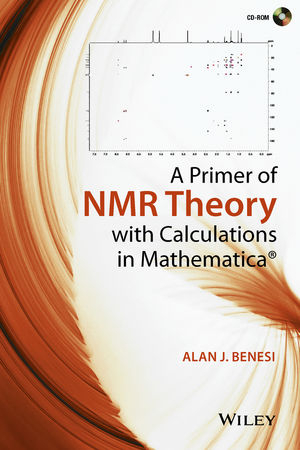
A Primer of NMR Theory with Calculations in Mathematica
John Wiley & Sons Inc (Verlag)
978-1-118-58899-4 (ISBN)
Presents the theory of NMR enhanced with Mathematica© notebooks
Provides short, focused chapters with brief explanations of well-defined topics with an emphasis on a mathematical description
Presents essential results from quantum mechanics concisely and for easy use in predicting and simulating the results of NMR experiments
Includes Mathematica notebooks that implement the theory in the form of text, graphics, sound, and calculations
Based on class tested methods developed by the author over his 25 year teaching career. These notebooks show exactly how the theory works and provide useful calculation templates for NMR researchers
Alan J. Benesi was Director of the Pennsylvania State University NMR Facility from 1987-2012. He earned his Ph.D. in Biophysics at the University of California, Berkeley, in 1975. He has published many papers related to solid state and liquid state NMR, solid state and liquid state NMR relaxation, and rotational and translational diffusion.
Preface viii
Chapter 1 Introduction 1
Chapter 2 Using Mathematicac; Homework Philosophy 3
Chapter 3 The NMR Spectrometer 4
Chapter 4 The NMR Experiment 7
Chapter 5 Classical Magnets and Precession 11
Chapter 6 The Bloch Equation in the Laboratory Reference Frame 16
Chapter 7 The Bloch Equation in the Rotating Frame 19
Chapter 8 The Vector Model 23
Chapter 9 Fourier Transform of the NMR Signal 29
Chapter 10 Essentials of Quantum Mechanics 31
Chapter 11 The Time]Dependent Schrodinger Equation, Matrix Representation of Nuclear Spin Angular Momentum Operators 35
Chapter 12 The Density Operator 39
Chapter 13 The Liouville–von Neumann Equation 41
Chapter 14 The Density Operator at Thermal Equilibrium 42
Chapter 15 Hamiltonians of NMR: Isotropic Liquid]State Hamiltonians 45
Chapter 16 The Direct Product Matrix Representation of Coupling Hamiltonians HJ and HD 50
Chapter 17 Solving the Liouville–Von Neumann Equation for the Time Dependence of the Density Matrix 54
Chapter 18 The Observable NMR Signal 59
Chapter 19 Commutation Relations of Spin Angular Momentum Operators 61
Chapter 20 The Product Operator Formalism 65
Chapter 21 NMR Pulse Sequences and Phase Cycling 68
Chapter 22 Analysis of Liquid]State NMR Pulse Sequences with the Product Operator Formalism 72
Chapter 23 Analysis of the Inept Pulse Sequence with Program Shortspin and Program Poma 78
Chapter 24 The Radio Frequency Hamiltonian 82
Chapter 25 Comparison of 1D and 2D NMR 86
Chapter 26 Analysis of the HSQC, HMQC, and DQF]COSY 2D NMR Experiments 89
Chapter 27 Selection of Coherence Order Pathways with Phase Cycling 96
Chapter 28 Selection of Coherence Order Pathways with Pulsed Magnetic Field Gradients 104
Chapter 29 Hamiltonians of NMR: Anisotropic Solid]State Internal Hamiltonians in Rigid Solids 111
Chapter 30 Rotations of Real Space Axis Systems—Cartesian Method 120
Chapter 31 Wigner Rotations of Irreducible Spherical Tensors 123
Chapter 32 Solid]State NMR Real Space Spherical Tensors 129
Chapter 33 Time]Independent Perturbation Theory 134
Chapter 34 Average Hamiltonian Theory 141
Chapter 35 The Powder Average 144
Chapter 36 Overview of Molecular Motion and NMR 147
Chapter 37 Slow, Intermediate, And Fast Exchange In Liquid]State Nmr Spectra 150
Chapter 38 Exchange in Solid]State NMR Spectra 154
Chapter 39 N MR Relaxation: What is NMR Relaxation and what Causes it? 163
Chapter 40 Practical Considerations for the Calculation of NMR Relaxation Rates 168
Chapter 41 The Master Equation for NMR Relaxation—Single Spin Species I 170
Chapter 42 Heteronuclear Dipolar and J Relaxation 183
Chapter 43 Calculation of Autocorrelation Functions, Spectral Densities, and NMR Relaxation Times for Jump Motions in Solids 189
Chapter 44 Calculation of Autocorrelation Functions and Spectral Densities for Isotropic Rotational Diffusion 198
Chapter 45 Conclusion 202
Bibliography 203
INDEX 000
| Erscheint lt. Verlag | 28.7.2015 |
|---|---|
| Verlagsort | New York |
| Sprache | englisch |
| Maße | 160 x 241 mm |
| Gewicht | 558 g |
| Themenwelt | Naturwissenschaften ► Chemie ► Analytische Chemie |
| Naturwissenschaften ► Physik / Astronomie ► Elektrodynamik | |
| ISBN-10 | 1-118-58899-1 / 1118588991 |
| ISBN-13 | 978-1-118-58899-4 / 9781118588994 |
| Zustand | Neuware |
| Haben Sie eine Frage zum Produkt? |
aus dem Bereich


